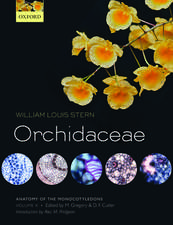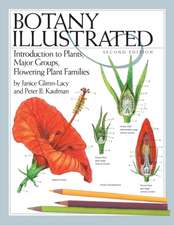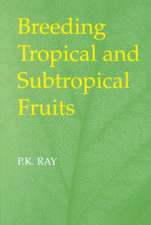Heartwood and Tree Exudates: Springer Series in Wood Science, cartea 4
Autor William E. Hillisen Limba Engleză Paperback – 10 dec 2011
Din seria Springer Series in Wood Science
- 18%
 Preț: 1543.84 lei
Preț: 1543.84 lei - 23%
 Preț: 2062.71 lei
Preț: 2062.71 lei - 18%
 Preț: 1824.32 lei
Preț: 1824.32 lei - 18%
 Preț: 2093.60 lei
Preț: 2093.60 lei - 24%
 Preț: 817.70 lei
Preț: 817.70 lei - 18%
 Preț: 1225.16 lei
Preț: 1225.16 lei - 18%
 Preț: 3288.92 lei
Preț: 3288.92 lei - 18%
 Preț: 948.29 lei
Preț: 948.29 lei - 18%
 Preț: 1222.31 lei
Preț: 1222.31 lei - 18%
 Preț: 946.87 lei
Preț: 946.87 lei - 15%
 Preț: 643.34 lei
Preț: 643.34 lei - 18%
 Preț: 1122.87 lei
Preț: 1122.87 lei - 18%
 Preț: 1020.30 lei
Preț: 1020.30 lei - 24%
 Preț: 836.40 lei
Preț: 836.40 lei - 20%
 Preț: 569.47 lei
Preț: 569.47 lei - 15%
 Preț: 638.89 lei
Preț: 638.89 lei - 15%
 Preț: 636.30 lei
Preț: 636.30 lei - 15%
 Preț: 635.31 lei
Preț: 635.31 lei - 18%
 Preț: 878.05 lei
Preț: 878.05 lei - 15%
 Preț: 646.43 lei
Preț: 646.43 lei - 18%
 Preț: 1004.67 lei
Preț: 1004.67 lei - 18%
 Preț: 894.03 lei
Preț: 894.03 lei - 15%
 Preț: 658.70 lei
Preț: 658.70 lei - 15%
 Preț: 641.53 lei
Preț: 641.53 lei - 18%
 Preț: 950.84 lei
Preț: 950.84 lei - 18%
 Preț: 783.35 lei
Preț: 783.35 lei - 15%
 Preț: 645.79 lei
Preț: 645.79 lei - 24%
 Preț: 880.78 lei
Preț: 880.78 lei -
 Preț: 388.13 lei
Preț: 388.13 lei - 18%
 Preț: 780.82 lei
Preț: 780.82 lei
Preț: 891.65 lei
Preț vechi: 1087.38 lei
-18% Nou
Puncte Express: 1337
Preț estimativ în valută:
170.61€ • 178.14$ • 141.21£
170.61€ • 178.14$ • 141.21£
Carte tipărită la comandă
Livrare economică 05-19 aprilie
Preluare comenzi: 021 569.72.76
Specificații
ISBN-13: 9783642725364
ISBN-10: 3642725368
Pagini: 288
Ilustrații: XIV, 268 p.
Dimensiuni: 170 x 244 x 15 mm
Greutate: 0.46 kg
Ediția:Softcover reprint of the original 1st ed. 1987
Editura: Springer Berlin, Heidelberg
Colecția Springer
Seria Springer Series in Wood Science
Locul publicării:Berlin, Heidelberg, Germany
ISBN-10: 3642725368
Pagini: 288
Ilustrații: XIV, 268 p.
Dimensiuni: 170 x 244 x 15 mm
Greutate: 0.46 kg
Ediția:Softcover reprint of the original 1st ed. 1987
Editura: Springer Berlin, Heidelberg
Colecția Springer
Seria Springer Series in Wood Science
Locul publicării:Berlin, Heidelberg, Germany
Public țintă
ResearchCuprins
1 Introduction.- 1.1 Prehistoric and Ancient Use.- 1.2 Changing Uses of Forests.- 2 Definitions and Descriptions.- 2.1 Introduction.- 2.2 Sapwood.- 2.3 Intermediate Wood.- 2.4 Transition Zone.- 2.5 Heartwood.- 2.6 Tree Exudates and Extracellular Materials.- 3 Historical Aspects.- 3.1 The Use of Durable Woods.- 3.2 Exudates.- 3.3 Varnishes and Lacquers.- 3.4 Gums.- 3.5 Tannins.- 3.6 Dyes.- 3.7 Perfumes.- 3.8 Rubber.- 3.9 Medicines.- 3.10 Lessons from History.- 4 Influence of Forestry Aspects.- 4.1 Variation of Heartwood Volume.- 4.2 Formation of Exudates.- 5 Chemical Features.- 5.1 Water and Gases.- 5.2 Inorganic Compounds.- 5.3 Storage Substances and Intermediates.- 5.4 Nitrogenous Compounds.- 5.5 Ethylene.- 5.6 Type of Extractives.- 5.7 Amount of Extractives.- 5.8 Reagents for Heartwood Detection.- 5.9 Exudates.- 6 Biological Features.- 6.1 Sapwood.- 6.2 Transition Zone.- 6.3 Heartwood.- 6.4 Wound Wood and Chemically Affected Wood.- 6.5 Exudates.- 7 Function, Formation, and Control of Heartwood and Extractives.- 7.1 Function and Volume of Sapwood.- 7.2 Types and Formation of Heartwood.- 7.3 Features of Heartwood and Woundwood.- 7.4 The Transition Zone and its Formation.- 7.5 Function of Extractives and Exudates.- 7.6 Formation of Exudates and Extractives.- 7.7 Initiation of Formation of Heartwood, Extractives, and Exudates.- 7.8 Factors Controlling the Nature of Extractives and Exudates.- 7.9 Activities at Cellular Levels.- 7.10 Conclusions.- References.











